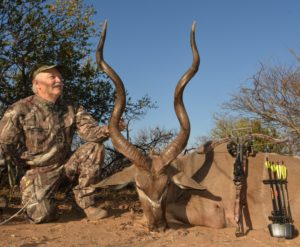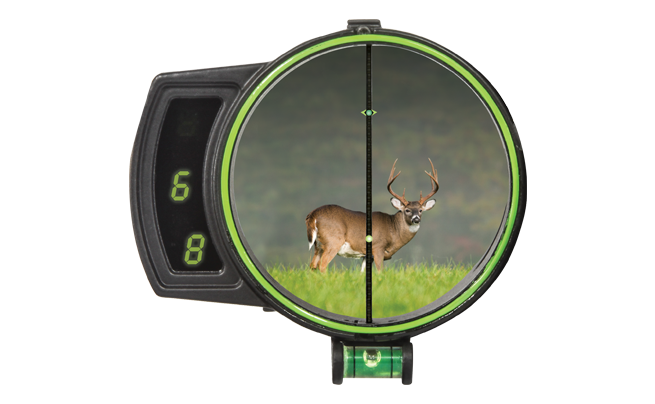A red dot sight can instantly make you a better shot and hunter. Each year, many archers muff a chance at a great trophy because they experience pin confusion, misjudge distance, or just can’t get a buck in their sight picture quickly enough. A red dot sight can solve all of these problems.
The Great Red Dot Experiment

I became an outdoor writer in the 1980s and 90’s when “writer hunts” were common. These occurred when a manufacturer invited a group of writers to try their products in the field under real hunting conditions. That marketing approach doesn’t happen these days, so I decided to create one of my own. I invited two friends on a safari. Although they paid their way, I borrowed three brands of crossbows, arrows, broadheads, and red dot scopes. I knew that kills on African antelope required pin-point accuracy and counted on the red dot scopes to make that happen.
Wow, did it! The hunt ended with 15 animals taken with 15 arrows, exactly the kind of accuracy I foresaw thanks to the advanced aiming system. Additionally, neither of my two friends had used a red dot before and I had limited experience. That hunt occurred back in 2015 and red dot scopes have progressed to the point that today, they are built for all types of shooting situations and equipment.
Mission Impossible-
Red dot scopes are so effective they can do things that seem impossible. Try this test and your friends will think it’s magic. Using a shooting bench or any rifle resting device, aim the red dot scope at a target with both eyes open. Ask a friend to put his or her hand over the front end of the scope. With vision blocked, one might think that the red dot will disappear, but it does not. Red dots are so intuitively simple that the human mind will transpose the red dot from your “aiming eye” to your “looking eye.”
It works every time, but people won’t believe it until they actually see it. A similar thing occurs with a round object and sighting. If you are used to a peep sight, you will notice that you don’t have to adjust your sight pin to the center of the peep. Like the red dot, your mind’s eye naturally centers the sight pin in the center of the circle. That same principle works with red dots as well. Although the red dot is in the center of the sight picture, you can tilt and cant the scope and as long as the dot is on the target, you hit.
Red or Green, Size Matters

Because some shooters are color blind, all red dots aren’t “red.” Some folks have better luck with a green dot and some optics leave the choice up to the user. The size of the dot can be a factor depending on how it will be used. At a meeting of the Professional Outdoor Media Association, a red dot company had a target range set up at distances from 25 yards out to 200. At first, I thought that the 200-yard gong was a joke, yet with a small diameter dot, one or two MOA, it can be very effective. I was able to ring the bell repeatedly at 200 yards and suddenly my attitude changed. With AR’s and other rifles designed for longer range, the smaller the diameter of the dot, the better.
For pistols, crossbows, and short-range shooting, a larger MOA dot such as 3, 5, or larger works well. The lead image above shows the dot of a Burris Oracle sight and notice how the small green dot allows for exact arrow placement even at maximum bowhunting range.
The new Fastfire III sights are even easier and quicker to use. They are smaller and align more nearly to the bore of your firearm or arrow channel of your crossbow. Many of these Burris optics have an automatic shut-off feature so that one battery will last for years.
Aim Small, Miss Small

Many hunters can punch bulls eyes all day on paper, but let a large antlered deer approach unexpectedly (which is most of the time) and they rush their shot, punching the release or firing at an awkward angle. Red dots show exactly where the bullet or arrow will strike allowing the hunter to avoid pin confusion, estimating range, or other calculations. Aim and shoot, it’s really that simple.
I’m setting up a really fast Barnett Hyper Ghost 425d for an elk hunt where I can only use a zero power scope with a single dot. With such a flat trajectory, I plan on sighting the scope at 30 yards so that I’m within the kill zone with a center shoulder aim out to 42 yards. I’ll be lucky if I get a full second to aim and shoot and this set-up will be perfect.
If you’ve not used a red dot scope before, check out all of the models on the Burris Optics website. One click and you are sure to find the right sight for you.



















![The Best Deer Camp Chili [VIDEO] Deer Chili Ingredients, Tomatoes, Chili Spices](/wp-content/uploads/2015/10/Deer-Chili-Deer-Camp-Recipe-218x150.jpg)
![How to Call Elk Early in the Season [VIDEO]](/wp-content/uploads/2016/08/byers003-218x150.jpg)




![Idiots Disturb Hunter: How Would You Have Handled It? [VIDEO]](/wp-content/uploads/2015/10/DSC00110-e1474487693878-100x70.jpg)
![Albino Buck Shocked to Shed His Antlers [VIDEO]](/wp-content/uploads/2015/10/AlbinoDeer-100x70.jpg)